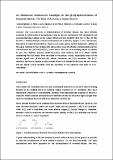Por favor, use este identificador para citar o enlazar a este item:
http://hdl.handle.net/10261/111096COMPARTIR / EXPORTAR:
 SHARE SHARE
 CORE
BASE CORE
BASE
|
|
| Visualizar otros formatos: MARC | Dublin Core | RDF | ORE | MODS | METS | DIDL | DATACITE | |

| Título: | An alternative mechanistic paradigm for the β-Z hydrosilylation of terminal alkynes: The role of acetone as a silane shuttle |
Autor: | Iglesias, Manuel CSIC ORCID; Sanz Miguel, Pablo J. CSIC ORCID; Polo, Víctor CSIC ORCID; Fernández-Álvarez, Francisco J. CSIC ORCID; Pérez-Torrente, Jesús J. CSIC ORCID; Oro, Luis A. CSIC ORCID | Palabras clave: | Silanes Hydrosilylation Homogeneous catalysis Carbenes Alkynes |
Fecha de publicación: | 2013 | Editor: | Wiley-VCH | Citación: | Chemistry - A European Journal 19(51): 17559-17566 (2013) | Resumen: | The β-Z selectivity in the hydrosilylation of terminal alkynes has been hitherto explained by introduction of isomerisation steps in classical mechanisms. DFT calculations and experimental observations on the system [M(I)2{κ-C,C,O,O-(bis-NHC)}]BF4 (M=Ir (3 a), Rh (3 b); bis-NHC=methylenebis(N-2-methoxyethyl)imidazole-2-ylidene) support a new mechanism, alternative to classical postulations, based on an outer-sphere model. Heterolytic splitting of the silane molecule by the metal centre and acetone (solvent) affords a metal hydride and the oxocarbenium ion [R 3Si - O(CH3)2]+, which reacts with the corresponding alkyne in solution to give the silylation product [R 3Si - CHï£C - R]+. Thus, acetone acts as a silane shuttle by transferring the silyl moiety from the silane to the alkyne. Finally, nucleophilic attack of the hydrido ligand over [R3Si - CHï£C - R]+ affords selectively the β-(Z)- vinylsilane. The β-Z selectivity is explained on the grounds of the steric interaction between the silyl moiety and the ligand system resulting from the geometry of the approach that leads to β-(E)-vinylsilanes. Silanes catch the shuttle: An outer-sphere mechanism that explains the β-Z hydrosilylation of terminal alkynes based on the role of acetone as a silane shuttle is disclosed. Heterolytic splitting of the silane molecule by the metal centre and acetone affords a metal hydride and the oxocarbenium ion [R 3Si - O(CH3)2]+, which reacts with the alkyne in solution to give the silylation product [R3Si - CHï£C - R]+ (see figure). © 2013 WILEY-VCH Verlag GmbH & Co. KGaA, Weinheim. | Versión del editor: | http://dx.doi.org/10.1002/chem.201303063 | URI: | http://hdl.handle.net/10261/111096 | DOI: | 10.1002/chem.201303063 | Identificadores: | issn: 0947-6539 e-issn: 1521-3765 |
| Aparece en las colecciones: | (ISQCH) Artículos |
Ficheros en este ítem:
| Fichero | Descripción | Tamaño | Formato | |
|---|---|---|---|---|
| Acetone as Silane Shuttle.pdf | 787,62 kB | Adobe PDF |  Visualizar/Abrir |
CORE Recommender
SCOPUSTM
Citations
74
checked on 30-mar-2024
WEB OF SCIENCETM
Citations
71
checked on 16-feb-2024
Page view(s)
368
checked on 18-abr-2024
Download(s)
590
checked on 18-abr-2024
Google ScholarTM
Check
Altmetric
Altmetric
NOTA: Los ítems de Digital.CSIC están protegidos por copyright, con todos los derechos reservados, a menos que se indique lo contrario.
